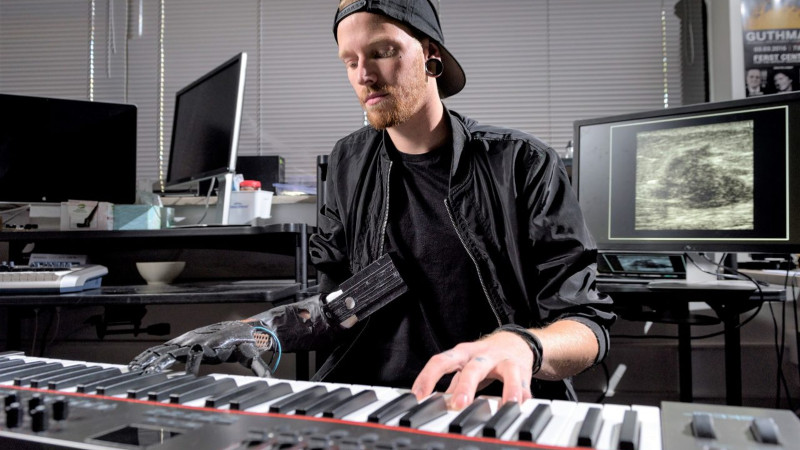Prostheses are a great help to those who have lost limbs, or who never had them in the first place. Over the past few decades there has been a great deal of research done to make these essential devices more useful, creating prostheses that are capable of movement and more accurately recreating the functions of human body parts. At Georgia Tech, they’re working on just that, with the help of AI.
[Jason Barnes] lost his arm in a work accident, which prevented him from playing the piano the way he used to. The researchers at Georgia Tech worked with him, eventually producing a prosthetic arm that, unlike most, actually has individual finger control. This is achieved through the use of an ultrasound probe, which is used to detect muscle movements elsewhere on his body, with enough detail to allow the control of individual fingers. This is done through a TensorFlow-based neural network which analyses the ultrasound data to determine which finger the user is trying to move. The use of ultrasound was the major breakthrough which made this possible; previous projects have often relied on electromyogram sensors to read muscle impulses but these lack the resolution required.
The prosthesis is nicknamed the “Skywalker arm”, after its similarities to the prostheses seen in the Star Wars films. It’s not [Jason]’s first advanced prosthetic, either – Georgia Tech has also equipped him with an advanced drumming prosthesis. This allows him to use two sticks with a single arm, the second stick using advanced AI routines to drum along with the music in the room.
It’s great to see music being used as a driver to create high-performance prosthetics and push the state of the art forward. We’re sure [Jason] enjoys performing with the new hardware, too. But perhaps you’d like to try something similar, even though you’ve got two hands already? Try this on for size.
[Thanks to Brian for the tip!]















https://fsmedia.imgix.net/ec/3b/8e/e9/4046/4f4f/a0ce/90ef09ddf8e1/luke-might-have-been-more-attached-to-the-hand-than-he-was-that-lightsaber.jpeg
In all seriousness though, this is REALLY, fundamentally, AMAZING! I know those mechanics have a ways to go, but the idea of a prosthetic with individual digit control, without mode switching… I can only imagine what it would be like to lose a hand… I love working with my hands. To genuinely get that back would be amazing! I hope this trickles down into something that can actually serve those who need it ASAP!
[Ed note: All good. Fixed.]
Not such a “severe” error, after all this is HackADay, and comment edits are verboten on their “server”.
B^)
It goes like this: we could allow editing of comments, but then we’d have to make people log in with verified identities to prevent folks from editing each others’ comments.
So we’re prioritizing your privacy, assuming you want it, but the price is that you’d better proofread before hitting “Post”.
But we’ve also got your back when it goes too wrong.
And thanks for that edit… what a typo though… I couldn’t decide whether to die laughing, or just die a little inside!
I see what you did there! LOL ◔ᴗ◔
As many of the fingers are controlled by muscles in the forearm, I look forward to medical science developing a system of coupling the severed tendons to small cables/straps/pulleys to actuate the finger movement.
The thumb muscle in the palm would have to be replaced with a servo, but hopefully that could be connected to the nerve which triggers it.
Granted that would not do anything for the lost sense of touch in the digits, but some feedback would be sensed by the muscles pulling the cables/straps.
The wrist joint would be difficult to reproduce, but I suspect some would be willing to put up with a fixed wrist to gain some finger movement.
having a system like that could be problematic, as you would have kind of an open wound and thus, all the problem that come with it
This is fantastic, the sensor’s resolution has been a huge brick wall for prosthetics. The only other nerve-reading tech I’ve seen with fine resolution is “optical magnetic field sensors”. There have been some tests on frog nerves but I haven’t seen a live person demo like this. If this tech is cheap enough we’ll finally start seeing legit replacement limbs.
This is awesome. Anything that gives people who have lost limbs their abilities back is awesome.
But..
How about those who haven’t lost limbs? Maybe we had an accident too. An accident of evolution! I can’t count the number of times an extra hand or two would have made a project go easier. I don’t have enough fingers to do so!
One day I want to experiment with this. I want to work out ways that a person who has all there limbs can control additional ones. I want to look like this guy! http://alturl.com/b5rnw Don’t you? What hardware hacker wouldn’t?
Are you with me?
I broke my thumb back in 2006. it sucked. After about the second week or so, I was so fed up not having an opposable thumb on my primary hand, that I began building a motorized thumb that would attach to the cast. I had it nearly finished… by the time the cast came off… >_>
Also… Was totally expecting Doc Ock. LOL
Quote: “who never had them in the first place”
Umm.. NO !!!
I was born with about half of my left forearm. Let me be clear: I AM HAPPY WITH THE WAY I AM. Anybody trying to force one of these “things” on me is in for a fight – it would HANDICAP me.
My folks *explicitly* ignored it. Best thing they could have done.
I am an embedded systems engineer. I build houses for a hobby. I make stuff. I have rebuilt cars and played a number of sports. Not looking for praise or pity.
For the very few things another hand would be .. handy .. I have a solution:
https://www.instructables.com/id/Fuzzy-Stump-Socket-Prosthetic/
Friggin do-gooders.